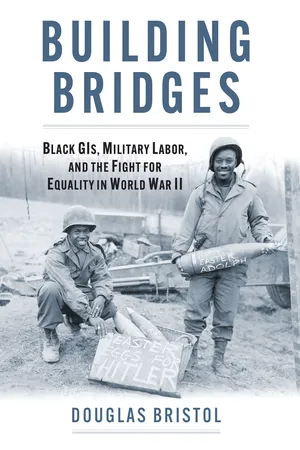
Building Bridges
Black GIs, Military Labor, and the Fight for Equality in World War II
- English
- ePUB (mobile friendly)
- Available on iOS & Android
Building Bridges
Black GIs, Military Labor, and the Fight for Equality in World War II
About this book
The previously overlooked story of how the labor of Black GIs helped win the war and advanced racial integration in the US armed forces.
More than 80 percent of Black GIs in World War II served behind the front lines. At the beginning of the war, segregation policies maintained physical separation of Black and white GIs and only allowed Black soldiers to do simple, menial work, maintaining a false sense of racial inferiority. But the mechanization of armed forces during World War II demanded more skilled laborers behind the front lines. The Army Service Forces, created in March 1942, turned to Black GIs to solve the serious manpower shortage and trained them for jobs previously done only by white GIs. In Building Bridges, author Douglas Bristol tells the story of how military necessity led to unprecedented changes in the employment of Black troops. These changes had unanticipated consequences. American military leaders adopted a new racial discourse that emphasized the rights and potential of Black GIs. The new opportunities also exposed racial discrimination, giving Black GIs and their allies more leverage to demand better treatment.
Black GIs built bridges, roads, and runways. They repaired engines and radios. They transported bombs, bullets, food, gasoline, and water to hard-pressed soldiers on the front lines. Their numbers, skills, and necessity only grew as the war continued. By the end of the World War II, Black GIs had cracked the glass ceiling in the racialized military hierarchy behind the front lines and became indispensable to keeping the American war machine running around the globe.
Frequently asked questions
- Essential is ideal for learners and professionals who enjoy exploring a wide range of subjects. Access the Essential Library with 800,000+ trusted titles and best-sellers across business, personal growth, and the humanities. Includes unlimited reading time and Standard Read Aloud voice.
- Complete: Perfect for advanced learners and researchers needing full, unrestricted access. Unlock 1.4M+ books across hundreds of subjects, including academic and specialized titles. The Complete Plan also includes advanced features like Premium Read Aloud and Research Assistant.
Please note we cannot support devices running on iOS 13 and Android 7 or earlier. Learn more about using the app.
Information
Table of contents
- Front Cover
- Half Title
- Series Page
- Title Page
- Copyright Page
- Table of Contents
- Series Editor’s Foreword
- Acknowledgments
- Introduction: War as Labor
- Chapter One. Separate but Equal? The Mobilization of Black Men before Pearl Harbor
- Chapter Two. The Opportunity Gap: Black GIs and Black Civilians in the United States
- Chapter Three. The “Conservative Revolution”: Transforming Roles for Black GIs in the Army Service Forces
- Chapter Four. Multiple New Roles for Black GIs: The Caribbean, Africa, and Middle East
- Chapter Five. Black GIs Become a Critical Lifeline for Allies: Transforming Logistics and Supply in Asia
- Chapter Six. Ending the Distinction between “White Jobs” versus “Black Jobs”: The Pacific Theater
- Chapter Seven. Participating in the Army and in Civilian Life: The European Theater
- Conclusion: Transnational Comparisons of Military Workplaces
- Notes
- Selected Bibliography
- Index
- Back Cover